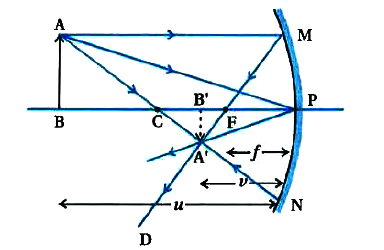Explain first focal centre and second focal centre for lens. Solution in Gujrati
(i) First focal point : Position of object from which image formed by lens at infinity is called first focal point (F1).

Second focal point : Position of point like image formed by lens for object at infinity is called second focal point (F2).

Topper's Solved these Questions
- BOOK - KUMAR PRAKASHANCHAPTER - RAY OPTICS AND OPTICAL INSTRUMENTSEXERCISE - SECTION - A (TRY YOURSELF)74videos
RAY OPTICS AND OPTICAL INSTRUMENTS
- BOOK - KUMAR PRAKASHANCHAPTER - RAY OPTICS AND OPTICAL INSTRUMENTSEXERCISE - SECTION-B (NUMERICALS)(NUMERICAL FROM TEXTUAL ILLUSTRATIONS)17videos
RAY OPTICS AND OPTICAL INSTRUMENTS
- BOOK - KUMAR PRAKASHANCHAPTER - MOVING CHARGES AND MAGNETISMEXERCISE - SECTION D (MCQs ASKED IN COMPETITIVE EXAMS)34videos
MOVING CHARGES AND MAGNETISM
- BOOK - KUMAR PRAKASHANCHAPTER - SAMPLE QUESTION PAPER EXERCISE - PART-B SECTION-C5videos
SAMPLE QUESTION PAPER
Similar Questions
Give range of wavelength of visible light.
02:13View SolutionSuppose that the lower half of the concave mirror.s reflecting surface as shown in figure is covered with an opaque (non-reflective) material. What effect will this have on the image of an object placed in front of the mirror ?
 01:12View Solution
01:12View SolutionElectric charge Q having mass M moves on a circular path of radius R with velocity →v, perpendicular to uniform magnetic field B. When a particle completes one revolution, work done by the field is _______
01:32View SolutionTwo charges –q and +q are located at points (0, 0, –a) and (0, 0, a), respectively.
(a) What is the electrostatic potential at the points (0, 0, z) and (x, y, 0) ?
(b) Obtain the dependence of potential on the distance r of a point from the origin when r/a>>1 .
(c) How much work is done in moving a small test charge from the point (5,0,0) to (–7,0,0) along the x-axis? Does the answer change if the path of the test charge between the same points is not along the x-axis?04:20View SolutionA convex lens of focal length 20cm is placed 10cm away from a second convex lens of focal length 25 cm. What wil be the location of the image of an object at 30 cm in front of the first lens?
 02:20View Solution
02:20View SolutionA convex lens of focal length f cut into parts first horizontally and then vertically. Find the focal length of part A of the lens, as shown:
03:43View SolutionDefine first principal focal length of a convex lens.
View SolutionAn object is placed 12 cm to the left of a converging lens of focal length 8cm . Another converging lens of 6 cm focal lengh is placed at a distance of 30 cm to the right of the first lens. The second lens will produce
05:29View SolutionA converging lens of focal length 50cm is placed co-axially in cintact with another lens of unknown focal length. If the combination behaves like a diverging lens of focal length 50cm, find the power and nature of second lens.
03:05View SolutionThe equiconvex lens has focal length f. If is cut perpendicular to the principal axis passin through optical centre, then focal length of each half is
01:48View SolutionThe distance between optic centre and centre of curvature is called as 'focal length'.
04:12View SolutionAn object is placed 12cm to the left of a converging lens of focal length 8cm. another converging lens of 6cm focal length is placed at a distance of 30cm to the right of the first lens. The second lens will produce
03:02View SolutionExplain first focal centre and second focal centre for biconvex lens by diagram.
03:10View SolutionExplain first focal centre and second focal centre for biconcave lens by diagram.
03:24View SolutionThe equiconvex lens has focal length f. If is cut perpendicular to the principal axis passing through optical centre, then focal length of each half is
05:59View Solution

